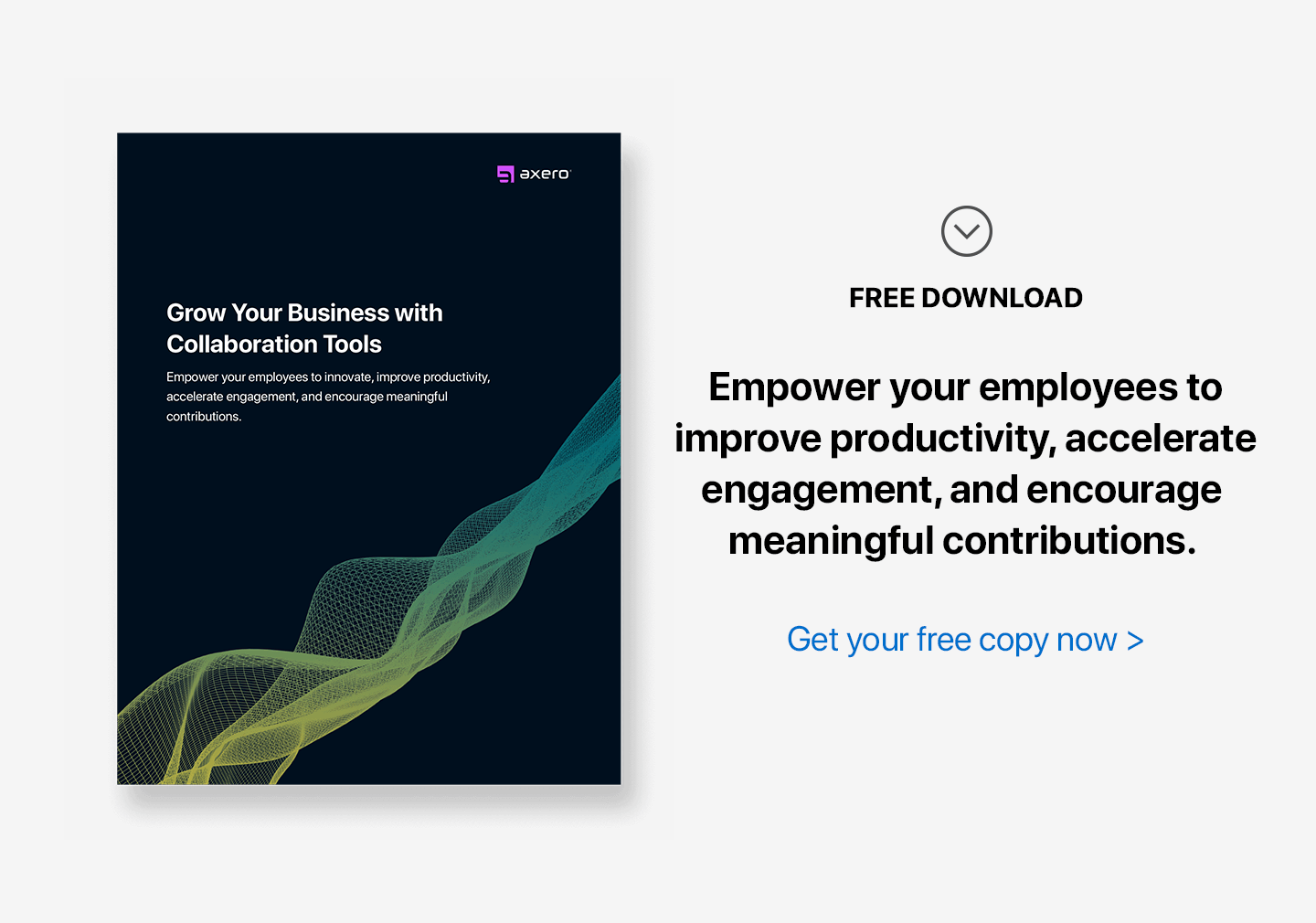Sharing & Collaborating on Standard Processes and Procedures.
— IT Director
I’m so glad someone in IT is talking about this challenge. Nothing kills an IT project like a lack of sharing and collaborating on standard processes and procedures. And, having spent my whole life in IT, I’ve seen the proof of this firsthand.
Now that I have my own IT company, I cannot let this happen. Not just at Axero, but at any of our customers either. I am talking about bringing new customers onto our platform. We close a bunch of sales every month—which means hundreds of new users who need new standard processes and procedures.
Our intranet software was built for sharing and collaboration. But IT has to lead the way. As companies migrate to our platform, they leave some of their old setups behind. Mostly, it’s a good thing. That’s why they come to us in the first place: because they want something better than what they have. But before everyone can enjoy the new technology, IT has to put its heads together to resolve conflicts and create new protocols.
No one in the business software world gets to close a sale without promising the buyer the cleanest, fastest, and least disruptive transition ever. And Axero is no exception. We spend weeks persuading customers that they have nothing to lose and everything to gain from switching to our platform. (Remind me to tell you about Influence and Pre-suasion next time we’re on the subject.)
It makes no sense, then, that we should then turn around and say it’s up to the customer to make it work—even though it’s the truth and they know it.
Here’s a likely scenario. We sell to HR, Corporate Communications, or the CEO. And IT is fighting it tooth and nail and gets stuck with it, anyway. So they won’t be surprised when nothing works as promised. They pretty much make sure it doesn’t until they’ve moved through all five stages of grief and have come out on the other side.
Being IT guys ourselves, we get it. We like our stuff, and we don’t want other people to tell us how to do our jobs. (Say hello to our old friend pettiness!) There are also pragmatic reasons for resisting the change.
So, we could blame the customer for being uncooperative, playing office politics, and that sort of thing. And we did. Then we realized that the best way to help the customer is to have a standard procedure of our own.
Now we sell a transition package together with the subscription. (We call them Launch Packages.) When customers sign up, they can choose from four plans, each plan with a detailed sequence of steps. We’ve tested these steps, and we know they work. We also understand that ignoring these steps doesn’t work. Now, all the customer has to do is get along amongst themselves. And, as the IT Director who gave us today’s challenge has observed, it’s not always easy. Here’s a story.
Soon after we signed up a new customer, the customer’s IT department was in full revolt. “We shouldn’t have bought this! It doesn’t meet our security standards!” I knew it had nothing to do with data security because many of our subscribers had much more stringent standards. But we couldn’t tell the customer to cut the bull and get to work. They needed to air their concerns first.
Matt, our tech support guy, and I came up with a plan. We would have a Q&A call with the entire customer’s IT team. We would answer their questions as briefly as we could, and just sit there and let them talk.
And that’s what we did. We had seven of them on the phone, all up in arms and ready to battle. It was the most circular conversation I’d ever heard, and it kept going on and on. Matt and I lost all hope of getting off the phones alive. But the people on the other end of the line worked it out. And they did it by themselves. After answering a few questions, all we had to do was to check off step one on our SCRUM board. Now the customer is on to step two.
A smart process can boost any part of a business. Wherever we don’t have a good system, we are leaving money on the table. That’s because there’s nothing creative about having no structure. More often than not, we end up doing the same things over again, anyway. And, unless we’ve thought through the steps, we are following our irrational habits, and the results are disappointing.
A case in point is our sales process at Axero. I used to leave it all up to our sales guy in the name of non-micromanagement, trust, and all those fun employee engagement ideas. But we’ve closed more deals in three months since his departure than in two years prior and made more money too.
What happened? Well, not much at first. We had too many leads coming in. And we were wasting time on unqualified prospects. We’d give them a proposal and never hear from them again. “Sorry, your price is too high.” So, we’ve learned to qualify prospects on price. Next, we turned it into a system—starting with the email asking for information. Can you tell me a little about your project? How many users? What is your timeframe? We’ve tested several emails and picked the one that had the best odds of getting a response. Then we made it a rule that we move no further in the sales process until they answer.
Next, we calculate the “investment” required on their part. If they want a demo, a final decision maker has to be present. Price, timeframe, goals, and the decision maker are all sorted out before the demo. This means we do only one demo per prospect—or no demo. Just with these few steps in place, our average sale cycle shrank from two months to less than a month.
Every company and every team must create its own process. Books and trade articles are helpful. I read them all the time. But you need to test the ideas on your product, your customers, and your people. The best part is that you learn how to test ideas and adapt them to your business, instead of taking them on blind faith or refusing them wholesale.
There’s no harm in having a standard process, as long as people know to improve and keep pace with changes. The process helps to train new people. Once trained, people help improve the process.
That said, improvement is in the eye of the beholder. Companies need to have clear metrics by which to judge their processes and procedures. In the case of the Axero sales process, I had to close a bunch of sales fast to convince my team that my method works. And I delivered.
There are also many intermediate metrics within a sale cycle. We could measure how long it takes to move through each step from the first contact to the close. We could average the results across all prospects. And we could keep measuring after they’ve become a customer. How long do the customers stick around? How much money do they spend with us? These are all the right things to measure. And having them at our fingertips has the power to motivate people to improve the process.
We are natural perfectionists, all of us. Perhaps, what our IT Director is missing are tools to spark the passion for perfecting the process among his people. If you’re into measuring and tracking as an engagement tool, check out Chapter 5, Keep the Eyes on the Prize, of Who the Hell Wants to Work for You?
_____
If you’re passionate about process improvement, you might like my book, because it covers hundreds of the best people-management practices in the world.












 info@axerosolutions.com
info@axerosolutions.com 1-855-AXERO-55
1-855-AXERO-55


